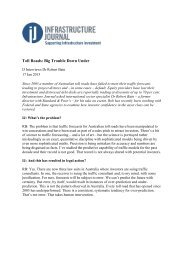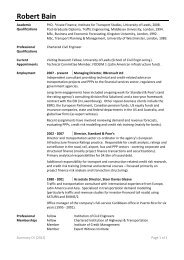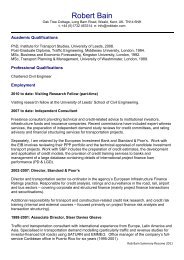Disincentivising overbidding for toll road concessions
Disincentivising overbidding for toll road concessions
Disincentivising overbidding for toll road concessions
- No tags were found...
Create successful ePaper yourself
Turn your PDF publications into a flip-book with our unique Google optimized e-Paper software.
5 │ CONCLUSIONS<br />
Other suggestions include designing a second-price system, whereby the winning bidder would pay the premium<br />
offered by the second-highest bidder, and making the bidding process more open and transparent. In theory, a<br />
second-price mechanism should incentivise bidders to reveal their true valuations. However, such designs are rarely<br />
used in practice and would be likely to result in lower revenues than the existing model.<br />
Structure of bid consortium<br />
Further problems in the bidding process have been created by the misalignment of incentives across bidding<br />
consortia. To overcome this, a requirement of pre-qualification could be to ensure that the bidding consortia are<br />
compliant with a target capital structure (eg, realistic gearing). Bidders might, <strong>for</strong> example, be required to show<br />
that they have a minimum of, say, 30% equity. While this may be partly required by the current market conditions<br />
anyway, enshrining a proper financing structure would be expected to reduce further the pressure on <strong>for</strong>ecasts. Thinly<br />
capitalised special-purpose vehicles (SPVs) do not sit naturally with projects exposed to income streams that may<br />
vary considerably from expectations.<br />
One element of an appropriately structured concession competition might be an evaluation of the bids that includes<br />
giving credit <strong>for</strong> the amount of equity, parent guarantees or similar support that are proffered and serve to provide<br />
‘skin in the game’ by the bidder. The more the concessionaire (at the parent level) is on-risk, the lower the incentive to<br />
overstate revenues or ‘overbid’ using an over-leveraged transaction structure.<br />
A number of additional structural features might be considered to ensure that the concessionaire has a long-term<br />
interest in the project, but the key ones are addressed above.<br />
A second possible means of ensuring closer incentive alignment would be to have a longer lock-up period on sponsor<br />
equity and make (real) sponsor equity a meaningful part of the overall equity pool. It would be desirable to prohibit<br />
dividend distributions or the sell-down of equity in circumstances of underper<strong>for</strong>ming projects, and to avoid the<br />
practice of passing equity risk to less-sophisticated third parties or to those unable to exercise full and appropriate<br />
due diligence.<br />
Key principle<br />
Mechanisms should be applied to increase the downside risk of <strong>overbidding</strong> and to penalise certain bidding<br />
consortia on the basis of their investment objectives and capital structures. This would reduce short-termism and<br />
create better incentive alignment across stakeholders within the consortia.<br />
5.1.4 Bid appraisal<br />
Best practice from international precedent suggests that, in the bid appraisal stage, procurers should scrutinise the<br />
deliverability of bidding parties’ business plans and the robustness of the assumptions behind their financial models.<br />
The UK DfT recently announced its intention to focus more on cost side as well as demand-side considerations in<br />
awarding franchises in the future. This is intended to encourage the realisation of efficiencies over the duration of the<br />
franchise, ensuring that infrastructure assets are efficiently utilised, while also reducing the incentive <strong>for</strong> parties to<br />
overbid. Similar criteria could be applied to bid assessment in the <strong>toll</strong> <strong>road</strong>s sector.<br />
While imposing rules to this effect might reduce the size of the upfront payment, this is a trade-off that the<br />
government might need to accept if it wishes to overcome the <strong>overbidding</strong> problem. The UK 3G spectrum auction<br />
is an example of a case in which the government agency emphasised that its objective was to maximise the<br />
full economic value of the auctioned resource rather than the revenues received. Since spectrum was a scarce<br />
resource—with only five licences <strong>for</strong> 13 bidders—the price paid by concessionaires remained high enough <strong>for</strong> the<br />
taxpayer to receive substantial benefits, but was not so high as to cause irreparable damage to the winning bidders’<br />
finances. This would likely also be the case in <strong>toll</strong> <strong>road</strong>s—owing to the infrequent nature of <strong>concessions</strong>, winning bids<br />
would be likely to remain at an acceptably high level, even if they were required to pass enhanced scrutiny.<br />
If the economic case <strong>for</strong> a project is sufficiently strong, instead of governments extracting money in the <strong>for</strong>m of<br />
upfront payments, they might more usefully do so in the <strong>for</strong>m of payment instalments over the lease period, which,<br />
even in NPV terms, could be smaller than the upfront payment would otherwise be. In GB rail franchising, the winning<br />
bidder pays annually rather than upfront. This removes some of the political pressure that incentivises the procurer<br />
63






